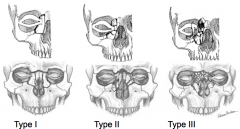![]()
![]()
![]()
Use LEFT and RIGHT arrow keys to navigate between flashcards;
Use UP and DOWN arrow keys to flip the card;
H to show hint;
A reads text to speech;
30 Cards in this Set
- Front
- Back
|
Vertical Buttresses
|
1. Naso-maxillary (NM)
2. Zygomatico-maxillary (ZM) 3. Pterygo-maxillary (PM) 4. Nasal septum |
|
|
Horizontal Beams
|
1. Frontal bar
2. Inferior orbital rims 3. maxillary alveolus and palate 4. zygomatic process 5. Greater wing of the sphenoid 6. Medial and lateral pterygoid plates 7. Mandible |
|
|
3 vaults of nose
|
Upper: nasal bones, ethmoid, superior edge of septum, vomer
Middle: upper lateral cartilage, septum, ascending process of maxilla Lower: lower lateral cartilages, inferior portion of septum |
|
|
Nasal Fractures Classification (Stranc & Robertson)
|
Plane 1: distal ends of nasal bones and septum only
Plane 2: involves entire distal portion of nasal bones and frontal process of maxilla at the piriform aperture. Septum is comminuted and begins to lose height Plane 3: Involvement of one or both frontal processes of maxilla at the piriform aperture. Fracture extends to frontal bone (NOE) |
|
|
Normal intercanthal distance
|
33mm (>35mm = abnormal)
|
|
|
Medial canthal tendon composition
|
anterior limb:
- superficial head of orbic - inserts onto frontal process of maxillary bone into anterior lacrimal crest posterior limb: - deep head of orbic - inserts onto posterior lacrimal crest |
|
|
Markowitz NOE Classification
|

Type 1:
- single central segment - no disruption medial canthal tendon (MCT) Type 2: - comminuted central segment - no disruption MCT Type 3: - severe comminuted central segment - disrupted/ avulsed MCT |
|
|
How is the eyelid traction test (Bowstring sign) useful in NOEs?
|
Grasp lower lid with forceps and pull laterally (opposite to MCT)
inability to pull lid taut = complete disruption of MCT |
|
|
4 fractures in an NOE
|
- frontal process of maxilla
- nasal bones - medial orbital wall - inferior orbital wall |
|
|
Surgical approaches to NOE
|
1: coronal
2: lower eyelid 3: gingival buccal sulcus incision 4: local incision (vertical, open sky, laceration) |
|
|
How to repair medial canthal tendon in NOE fracture
|
- Transnasal wiring (30 gauge wire)
- posterior/superior to lacrimal apparatus - tendon repaired with 2-0 nonabsorbable suture |
|
|
What drains into middle meatus?
|
maxillary sinus, frontal sinus, anterior cells of ethmoid sinus
|
|
|
What drains into inferior meatus?
|
Nasolacrimal canal
|
|
|
What drains into superior meatus?
|
posterior ethmoidal cells
|
|
|
What is the Foramina of Breschet?
|
- site of venous drainage of the frontal sinus mucosa
- potential route of intracranial spread of infection |
|
|
What is the risk if mucosa of frontal sinus is not completely obliterated in cranialization?
|
Mucocele formation
|
|
|
What separates frontal sinus from brain?
|
Cribiform plate
|
|
|
Indications for surgery in frontal sinus fracture
|
- anterior table displacement with contour change
- nasofrontal duct involvement - displaced posterior table |
|
|
When do you obliterate frontal sinus?
|
if nasofrontal duct involved
*NOE, medial/superior orbital, orbital floor fractures assumed to have nasofrontal duct involvement |
|
|
When do you perform cranialization?
|
if CSF leak and posterior table is displaced, or if it is non-displaced but leak is persistent > 4-7days
- involves removal of posterior table, obliteration of nasofrontal duct, reduction of anterior wall |
|
|
Muscles that attach to zygoma
|
- masseter
- temporalis - zygomaticus - zygomatic head of quadratus labii superioris |
|
|
Fracture sites of Lefort 1
|
AKA Guerin or transverse Fracture
1: Pterygoid plates 2: Pyriform aperture (inferior medial maxillary buttress) 3: alveolar maxilla (inferior lateral maxillary buttress) |
|
|
Fracture sites of Lefort 2
|
AKA Pyramidal fracture
1: pterygoid plates 2: nasofrontal junction 3: medial aspect of inferior orbital rim (transverse maxillary buttress) 4: lateral maxillary buttress |
|
|
Fracture sites of Lefort 3
|
1: pterygoid plates
2: nasofrontal junction 3: entire orbital floor 4: zygomaticofrontal suture (upper transverse maxillary buttress) 5: zygomaticosphenoid suture |
|
|
Hendrickson palate fracture classification
|
Type I Anterior and posterolateral alveolar
Type II Sagittal Type III Para-sagittal Type IV Para-alveolar Type V Complex Type VI Transverse |
|
|
How common is CSF leak in Lefort 2 and 3?
|
25-50%
|
|
|
Most common facial fractures
|
1. Mandible
2. zygoma 3. orbit |
|
|
Percentage of facial fractures with C-spine injury
|
7% (14% of c-spine injuries have facial fractures)
|
|
|
Percentage of facial fractures with brain injury
|
68%
|
|
|
Percentage of ocular injury
|
25%
|

